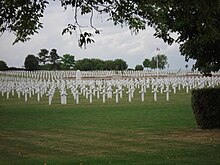Souain-Perthes-lès-Hurlus
| Souain-Perthes-lès-Hurlus | ||
|---|---|---|
|
|
||
| region | Grand Est | |
| Department | Marne | |
| Arrondissement | Châlons-en-Champagne | |
| Canton | Argonne Suippe et Vesle | |
| Community association | Region de Suippes | |
| Coordinates | 49 ° 11 ′ N , 4 ° 33 ′ E | |
| height | 128-202 m | |
| surface | 53.12 km 2 | |
| Residents | 238 (January 1, 2017) | |
| Population density | 4 inhabitants / km 2 | |
| Post Code | 51600 | |
| INSEE code | 51553 | |
Souain-Perthes-lès-Hurlus is a French commune with 238 inhabitants (as of January 1, 2017) in the Marne department in the Grand Est region . It belongs to the canton of Argonne Suippe et Vesle (until 2015: canton of Suippes ).
history
During the First World War , the two villages of Souain and Perthes-lès-Hurlus were affected in several ways: on the one hand, the region was the scene of the fighting for Souain, of which numerous monuments testify, and on the other hand, the French army carried out the so-called Souain experiment under the leadership of General Philippe Pétain through. Here, prototypes of tracked vehicles by the US inventor Benjamin Holt were tested for their field suitability, which ultimately led to the commissioning of the Schneider CA1 , the first French armored fighting vehicle . The village of Souain also included the Wacques Vorwerk (La Ferme aux Wacques), which was completely destroyed in 1916, on the grounds of which the La Ferme des Wacques necropolis was built after the end of the war . After the war, both villages were largely devastated and merged to form the municipality of Souain-Perthes-lès-Hurlus.
Population development
| year | 1962 | 1968 | 1975 | 1982 | 1990 | 1999 | 2008 | 2014 |
|---|---|---|---|---|---|---|---|---|
| Residents | 195 | 184 | 138 | 168 | 203 | 193 | 205 | 227 |
| Source: Cassini and INSEE | ||||||||
Personalities
- François Flameng (1856–1923), painter and professor at the Académie des Beaux-Arts in Paris
Memorial sites
In the area of Souain Perthes-lès-Hurlus there are several testimonies of the First World War. The ossuary of Navarino, the ossuary of the Foreign Legion Farnsworth , the cemetery of the 28th Brigade, the French and German Cemetery la Crouée , the cemetery de l'Opéra and several casemates are evidence of the severity of the four-year-long struggle. On the German war cemetery of Souain there is a collective grave for 11,320 soldiers u. a. buried the painter August Macke .
Web links
Individual evidence
- ^ Ex Collection "RF" (Detlef Dähn), in the Weltbildarchiv Berlin
- ^ Volksbund Deutsche Kriegsgräberfürsorge e. V. (Ed.): “Don't let my pictures die.” Artist portraits. Kassel 2010, p. 9.
- ^ The Souain-Perthes-lès-Hurlus military cemeteries , accessed on October 12, 2017.


